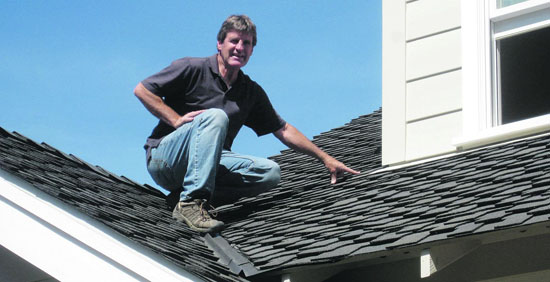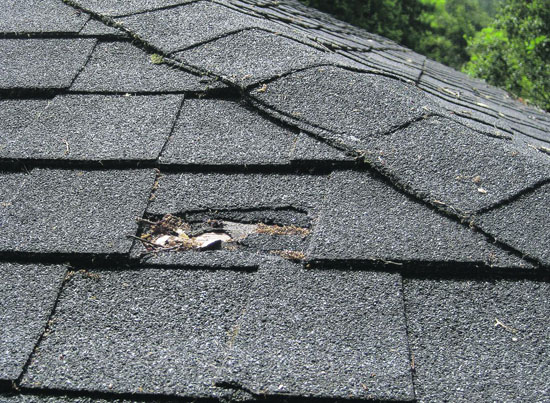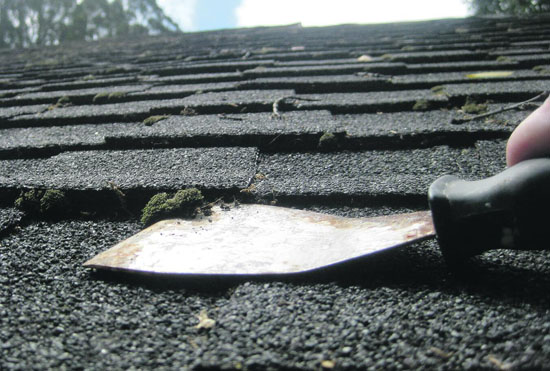 | | | Roofing contractor Peter Eva of Lafayette points out where summer inspections could begin: where the shingles meet the flashing. Make sure it's overlapping, that there are no gaps, and that debris is cleared. Photo Chris Lavin | | | | | | I t's happened to many of us: A big rain storm hits in the winter, then a strange, regular "kerplunk" starts coming from somewhere, probably nowhere near a bathroom or kitchen, and hopefully not from a gathering puddle on the bed. You get out the bucket, and get on Yelp to look for a contractor to line up for summertime. Right?
 Not necessarily, says Peter Eva, who runs Skyline Roofing in Lafayette. A roof should last a good 20 to 25 years, he says, and there is no reason to think you'll have to take out a second mortgage - or give up your family's summer vacation - to pay for a new one.
Not necessarily, says Peter Eva, who runs Skyline Roofing in Lafayette. A roof should last a good 20 to 25 years, he says, and there is no reason to think you'll have to take out a second mortgage - or give up your family's summer vacation - to pay for a new one.
 "Don't panic when you get a leak, especially in a rain storm that's coming from a direction that's different than usual," Eva said recently while supervising the installation of a new roof on a remodel in Lafayette. "When it's really raining, and there are high winds, the water is going to get blown in somewhere."
"Don't panic when you get a leak, especially in a rain storm that's coming from a direction that's different than usual," Eva said recently while supervising the installation of a new roof on a remodel in Lafayette. "When it's really raining, and there are high winds, the water is going to get blown in somewhere."
 That said, he explained, summertime is the time to act - on prevention. According to the National Roofing Contractors Association, new roofs can cost anywhere from $10,000 for a 2,000-square-foot home to above six figures for some Lamorinda homes, depending on the type of roof, how difficult it is to climb, and the substrate materials. So, as the saying goes, "a stitch in time saves nine," or in other words, a small repair now can save big bucks later.
That said, he explained, summertime is the time to act - on prevention. According to the National Roofing Contractors Association, new roofs can cost anywhere from $10,000 for a 2,000-square-foot home to above six figures for some Lamorinda homes, depending on the type of roof, how difficult it is to climb, and the substrate materials. So, as the saying goes, "a stitch in time saves nine," or in other words, a small repair now can save big bucks later.
 "The most important thing is keeping the roof clean," Eva said. "Debris build-up makes the water go places it isn't meant to go."
"The most important thing is keeping the roof clean," Eva said. "Debris build-up makes the water go places it isn't meant to go."
 But here Eva rushes in with a caveat that he seems to bring up in every other sentence. You'd think that ladders are serial killers.
But here Eva rushes in with a caveat that he seems to bring up in every other sentence. You'd think that ladders are serial killers.
 "You have to be very, very careful around ladders," Eva said. "People do not take ladders seriously enough. I've seen people climb onto roofs from step-ladders that are below the eaves."
"You have to be very, very careful around ladders," Eva said. "People do not take ladders seriously enough. I've seen people climb onto roofs from step-ladders that are below the eaves."
 He visibly shuddered at this. No, he says. No, no, no.
He visibly shuddered at this. No, he says. No, no, no.
 "Never do it by yourself," he said. (Naturally he repeated this several more times, as well.) "And make sure to have the right equipment. A ladder has to extend over a gutter by at least four feet, and not at too sharp of an angle. Get the right ladder and make sure the footing is secure."
"Never do it by yourself," he said. (Naturally he repeated this several more times, as well.) "And make sure to have the right equipment. A ladder has to extend over a gutter by at least four feet, and not at too sharp of an angle. Get the right ladder and make sure the footing is secure."
 So, we get that.
So, we get that.
 Here are Eva's other tips on what you can do this summer, after you get that safe, tall ladder on to secure footing with someone holding the bottom:
Here are Eva's other tips on what you can do this summer, after you get that safe, tall ladder on to secure footing with someone holding the bottom:
 � Wear soft-soled shoes; don't go barefoot. It's better for the roof. And roofs can get hotter than you expect. After he says to wear soft-soled shoes, he said don't think about walking on a roof at all if it's shake or tile. "Get someone else to do it or you can cause a lot of damage," he said. He also said get the "someone else" locally. "You don't want to get a roofer from Fremont who comes and makes a repair and then you need him again, and he can't make it," Eva said.
� Wear soft-soled shoes; don't go barefoot. It's better for the roof. And roofs can get hotter than you expect. After he says to wear soft-soled shoes, he said don't think about walking on a roof at all if it's shake or tile. "Get someone else to do it or you can cause a lot of damage," he said. He also said get the "someone else" locally. "You don't want to get a roofer from Fremont who comes and makes a repair and then you need him again, and he can't make it," Eva said.
 � Look for leaves and debris that collect, especially behind chimneys. That stops water from flowing, causes it to pool in little wet areas that salamanders will love, but so will roof rot.
� Look for leaves and debris that collect, especially behind chimneys. That stops water from flowing, causes it to pool in little wet areas that salamanders will love, but so will roof rot.
 � Get the leaves and debris off the edges of skylights and from the valleys.
� Get the leaves and debris off the edges of skylights and from the valleys.
 � Do not use a power washer to do this. (Remember the rain coming from weird directions makes weird things happen down below. The same will be true of power washing.)
� Do not use a power washer to do this. (Remember the rain coming from weird directions makes weird things happen down below. The same will be true of power washing.)
 � Just before the rains: Clean gutters.
� Just before the rains: Clean gutters.
 � Test the downspouts by running a hose down and making sure they flow out the other end. If not, tap the downspouts gently with a hammer to find blockages.
� Test the downspouts by running a hose down and making sure they flow out the other end. If not, tap the downspouts gently with a hammer to find blockages.
 � Put wire mesh over your gutters.
� Put wire mesh over your gutters.
 � Try to find the source of your leak, if you had one in the rains: It's probably caused by something clogged, and because water has to have someplace to run, it's going to back up.
� Try to find the source of your leak, if you had one in the rains: It's probably caused by something clogged, and because water has to have someplace to run, it's going to back up.
 � Replace worn rubber collars with new ones over the plumbing vent pipes.
� Replace worn rubber collars with new ones over the plumbing vent pipes.
 � Blackjack the flashing around skylights if you know the leak is coming from there.
� Blackjack the flashing around skylights if you know the leak is coming from there.
 The question arose as to how to perform these summertime maintenance activities without walking on the roof.
The question arose as to how to perform these summertime maintenance activities without walking on the roof.
 "Well, you can walk on it, but not very much," he said. "It deteriorates with each step you take."
"Well, you can walk on it, but not very much," he said. "It deteriorates with each step you take."
 At this point in the interview Eva was horrified (at least he looked that way) to find that a certain reporter liked to take a hot cup of tea up to the roof every month on the full moon to get a good view as it rose.
At this point in the interview Eva was horrified (at least he looked that way) to find that a certain reporter liked to take a hot cup of tea up to the roof every month on the full moon to get a good view as it rose.
 "Just," he said, "just don't do that."
"Just," he said, "just don't do that."
 So when the full moon rises, watch it from somewhere else.--
So when the full moon rises, watch it from somewhere else.--

|


